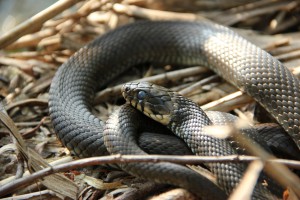Grass snake
 This most common and widespread species of the genus is numerous in this region. Grass snakes are easily distinguishable from all other snakes of the area by the two big and well-visible light spots (yellow, orange or dingy white) on the sides of the head. These spots are in the shape of a crescent, lined with black on the front and back. Individual species may present hardly visible or no light spots at all. Grass snakes can reach up to 1.5 m in length, but commonly would not exceed 1 m, with females notably bigger. These snakes’ habitats are extremely diverse, given they are sufficiently humid. They are most multiple on the banks of quiet rivers, lakes, ponds, and meadow moors, in humid woods and bushy floodplains. They make shelter in cavities of tree roots, piles of rock, rodent holes, hay stacks, clefts between logs in bridges and dams etc. Grass snakes are very active and agile. They crawl fast, can climb up trees and are excellent swimmers by the wriggling characteristic of all snakes. Grass snakes can leave riverbanks many kilometers behind and stay underwater dozens of minutes. They are diurnal, hiding in their shelters at night. In July-August, females lay one portion of 6 to 30 soft parchment-covered eggs, which often stick together like a bead string. The eggs can easily die of dry-up, this is why the snake lays them in humid but heat-retaining (25-30 °С) nooks: in the thick of foliage, wet moss, manure piles and even dumpsters, abandoned rodent holes, and rotten stumps. The young emerging from their shells are about 15 cm long; they crawl apart right away and start their independent lives. For wintering, grass snakes hide in deep rodent holes, in crevices of beach cliffs, under the roots of rotten trees. They prey on smaller frogs, toads and the young of those. On rare occasions they can prey on lizards, smaller birds and their nestlings, as well as small mammals, including new-born water-rats and muskrats. Young snakes often hunt insects.
This most common and widespread species of the genus is numerous in this region. Grass snakes are easily distinguishable from all other snakes of the area by the two big and well-visible light spots (yellow, orange or dingy white) on the sides of the head. These spots are in the shape of a crescent, lined with black on the front and back. Individual species may present hardly visible or no light spots at all. Grass snakes can reach up to 1.5 m in length, but commonly would not exceed 1 m, with females notably bigger. These snakes’ habitats are extremely diverse, given they are sufficiently humid. They are most multiple on the banks of quiet rivers, lakes, ponds, and meadow moors, in humid woods and bushy floodplains. They make shelter in cavities of tree roots, piles of rock, rodent holes, hay stacks, clefts between logs in bridges and dams etc. Grass snakes are very active and agile. They crawl fast, can climb up trees and are excellent swimmers by the wriggling characteristic of all snakes. Grass snakes can leave riverbanks many kilometers behind and stay underwater dozens of minutes. They are diurnal, hiding in their shelters at night. In July-August, females lay one portion of 6 to 30 soft parchment-covered eggs, which often stick together like a bead string. The eggs can easily die of dry-up, this is why the snake lays them in humid but heat-retaining (25-30 °С) nooks: in the thick of foliage, wet moss, manure piles and even dumpsters, abandoned rodent holes, and rotten stumps. The young emerging from their shells are about 15 cm long; they crawl apart right away and start their independent lives. For wintering, grass snakes hide in deep rodent holes, in crevices of beach cliffs, under the roots of rotten trees. They prey on smaller frogs, toads and the young of those. On rare occasions they can prey on lizards, smaller birds and their nestlings, as well as small mammals, including new-born water-rats and muskrats. Young snakes often hunt insects.
/ * The photos at lake.peipsi.org are cross-posted from commons.wikimedia.org and are used for familiarization purposes only. No commercial use of the photos is allowed. For more information about to use the photos see the originals on commons.wikimedia.org. /


